2012 TOYOTA VERSO engine overheat
[x] Cancel search: engine overheatPage 4 of 588

TABLE OF CONTENTSIndex
4
VERSO_WE_OM64524E
Seat heaters* ...................... 368
Armrest* .............................. 370
Front seatback table* .......... 371
Panoramic roof shade* ....... 373
Rear side sunshades*......... 376
Floor mat............................. 377
Luggage compartment fea-
tures..................................379
4-1. Maintenance and care
Cleaning and protecting the ve-
hicle exterior ..................... 388
Cleaning and protecting the ve-
hicle interior ...................... 392
4-2. Maintenance
Maintenance requirements . 395
4-3. Do-it-yourself maintenance
Do-it-yourself service precau-
tions .................................. 398
Hood ................................... 401
Positioning a floor jack ........ 403
Engine compartment........... 405
Tires .................................... 421
Tire inflation pressure ......... 424
Wheels ................................ 426
Air conditioning filter ........... 428
Key battery.......................... 432
Checking and replacing fus-
es.......................................436
Light bulbs .......................... 4505-1. Essential information
Emergency flashers ........... 464
If your vehicle needs to be
towed..............................465
If you think something is
wrong...............................473
Fuel pump shut off system (gas-
oline engine) .................... 474
5-2. Steps to take in an emergency
If a warning light turns on or a
warning buzzer sounds... . 475
If a warning message is dis-
played .............................. 479
If you have a flat tire (vehicles
with spare tire) ................. 490
If you have a flat tire (vehicles
with emergency tire puncture
repair kit) .......................... 506
If the engine will not start ... 519
If the shift lever cannot be shifted
from P (vehicles with a Multid-
rive or an automatic transmis-
sion) ................................. 522
If you lose your keys .......... 523
If you cannot operate the back
door opener...................... 524
If the electronic key does not op-
erate properly (vehicles with
smart entry & start sys-
tem).................................525
If the vehicle battery is dis-
charged ............................ 528
If your vehicle overheats .... 532
4Maintenance and care
5When trouble arises
Page 178 of 588
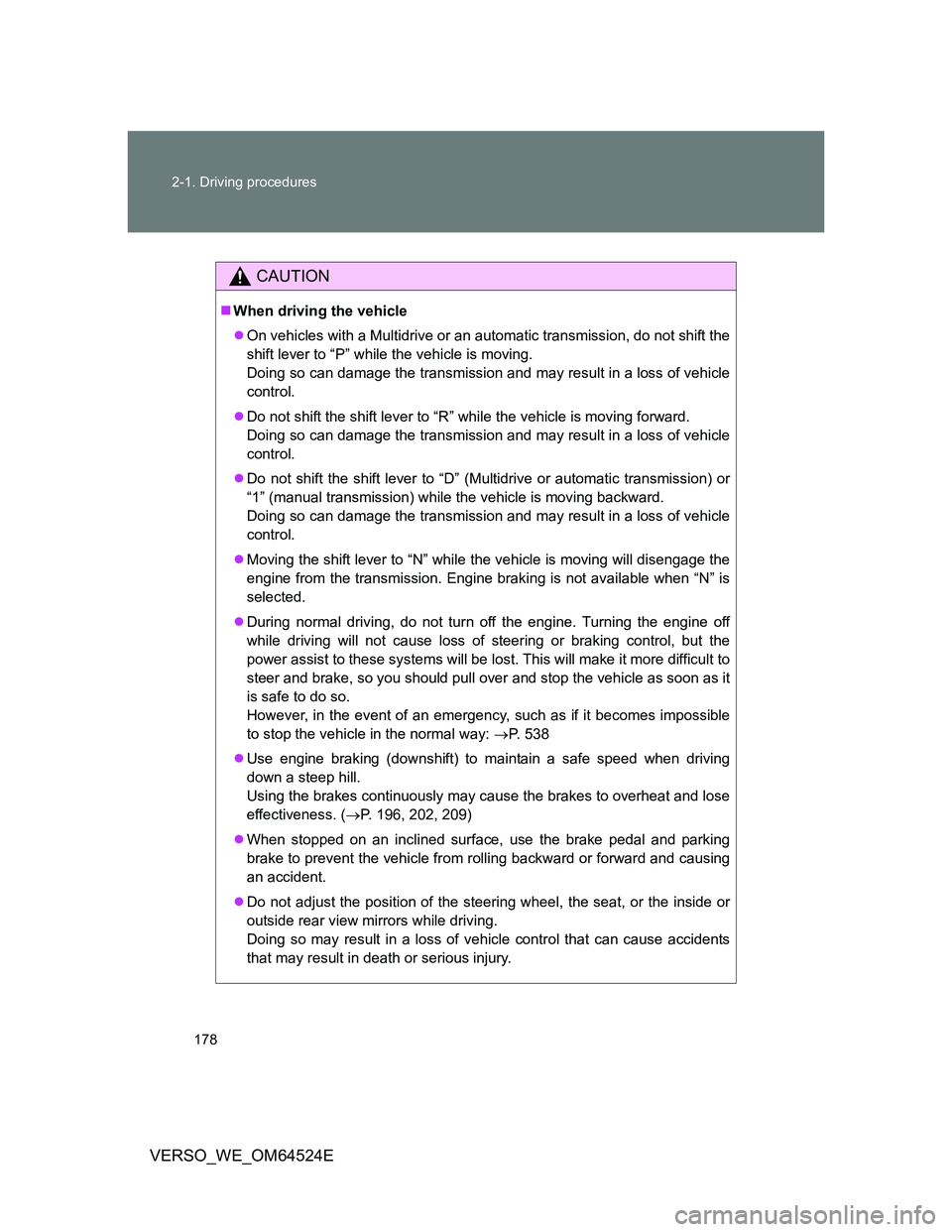
178 2-1. Driving procedures
VERSO_WE_OM64524E
CAUTION
When driving the vehicle
On vehicles with a Multidrive or an automatic transmission, do not shift the
shift lever to “P” while the vehicle is moving.
Doing so can damage the transmission and may result in a loss of vehicle
control.
Do not shift the shift lever to “R” while the vehicle is moving forward.
Doing so can damage the transmission and may result in a loss of vehicle
control.
Do not shift the shift lever to “D” (Multidrive or automatic transmission) or
“1” (manual transmission) while the vehicle is moving backward.
Doing so can damage the transmission and may result in a loss of vehicle
control.
Moving the shift lever to “N” while the vehicle is moving will disengage the
engine from the transmission. Engine braking is not available when “N” is
selected.
During normal driving, do not turn off the engine. Turning the engine off
while driving will not cause loss of steering or braking control, but the
power assist to these systems will be lost. This will make it more difficult to
steer and brake, so you should pull over and stop the vehicle as soon as it
is safe to do so.
However, in the event of an emergency, such as if it becomes impossible
to stop the vehicle in the normal way: P. 538
Use engine braking (downshift) to maintain a safe speed when driving
down a steep hill.
Using the brakes continuously may cause the brakes to overheat and lose
effectiveness. (P. 196, 202, 209)
When stopped on an inclined surface, use the brake pedal and parking
brake to prevent the vehicle from rolling backward or forward and causing
an accident.
Do not adjust the position of the steering wheel, the seat, or the inside or
outside rear view mirrors while driving.
Doing so may result in a loss of vehicle control that can cause accidents
that may result in death or serious injury.
Page 180 of 588
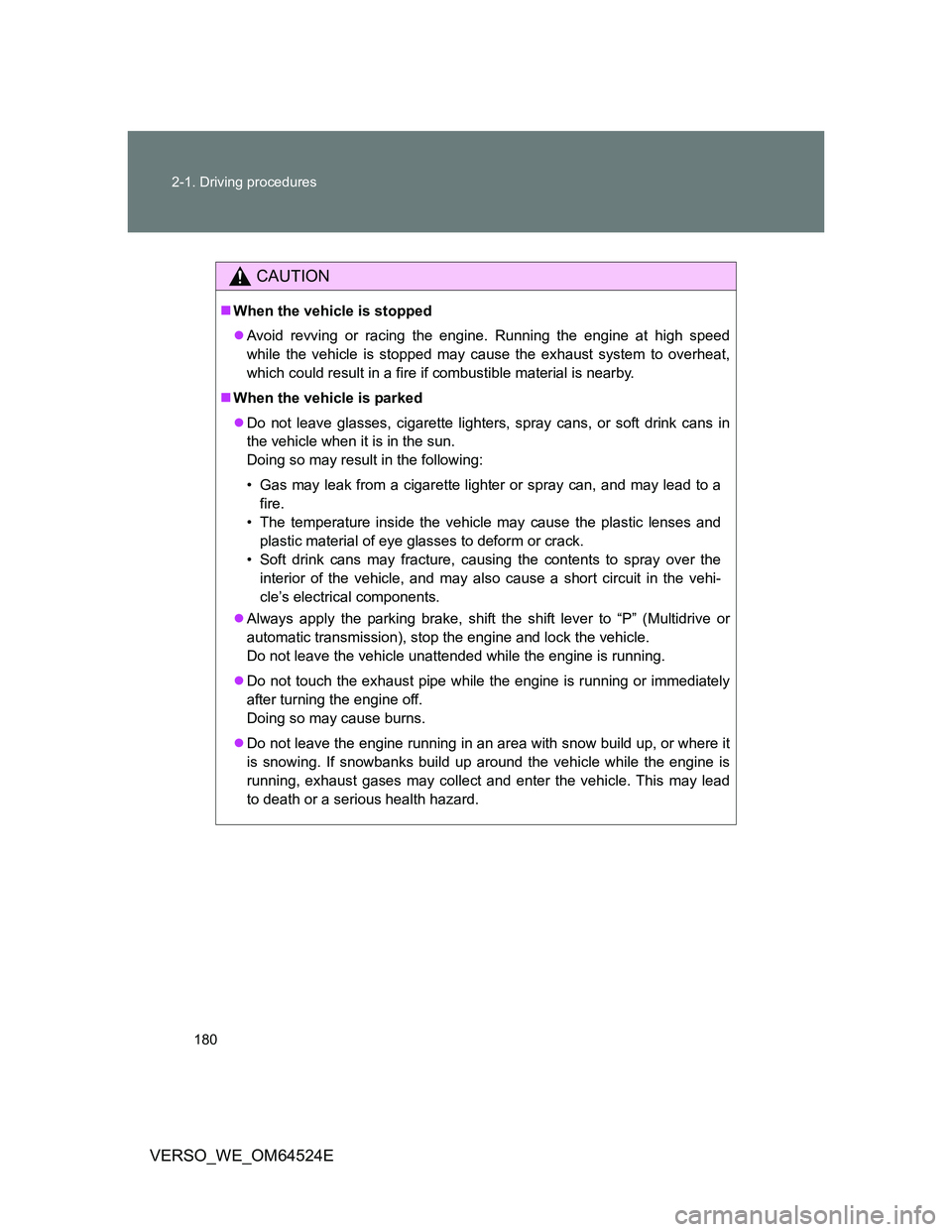
180 2-1. Driving procedures
VERSO_WE_OM64524E
CAUTION
When the vehicle is stopped
Avoid revving or racing the engine. Running the engine at high speed
while the vehicle is stopped may cause the exhaust system to overheat,
which could result in a fire if combustible material is nearby.
When the vehicle is parked
Do not leave glasses, cigarette lighters, spray cans, or soft drink cans in
the vehicle when it is in the sun.
Doing so may result in the following:
• Gas may leak from a cigarette lighter or spray can, and may lead to a
fire.
• The temperature inside the vehicle may cause the plastic lenses and
plastic material of eye glasses to deform or crack.
• Soft drink cans may fracture, causing the contents to spray over the
interior of the vehicle, and may also cause a short circuit in the vehi-
cle’s electrical components.
Always apply the parking brake, shift the shift lever to “P” (Multidrive or
automatic transmission), stop the engine and lock the vehicle.
Do not leave the vehicle unattended while the engine is running.
Do not touch the exhaust pipe while the engine is running or immediately
after turning the engine off.
Doing so may cause burns.
Do not leave the engine running in an area with snow build up, or where it
is snowing. If snowbanks build up around the vehicle while the engine is
running, exhaust gases may collect and enter the vehicle. This may lead
to death or a serious health hazard.
Page 181 of 588
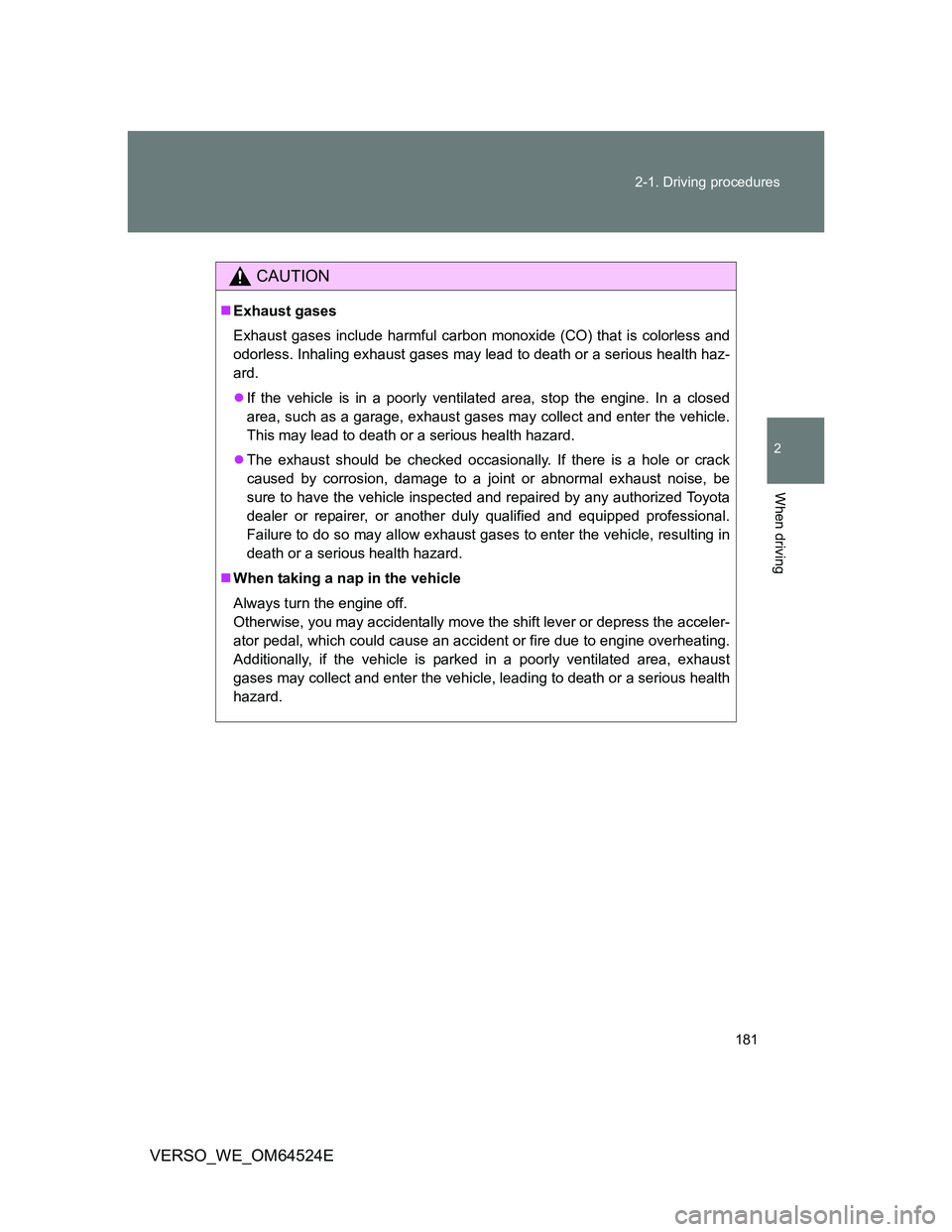
181 2-1. Driving procedures
2
When driving
VERSO_WE_OM64524E
CAUTION
Exhaust gases
Exhaust gases include harmful carbon monoxide (CO) that is colorless and
odorless. Inhaling exhaust gases may lead to death or a serious health haz-
ard.
If the vehicle is in a poorly ventilated area, stop the engine. In a closed
area, such as a garage, exhaust gases may collect and enter the vehicle.
This may lead to death or a serious health hazard.
The exhaust should be checked occasionally. If there is a hole or crack
caused by corrosion, damage to a joint or abnormal exhaust noise, be
sure to have the vehicle inspected and repaired by any authorized Toyota
dealer or repairer, or another duly qualified and equipped professional.
Failure to do so may allow exhaust gases to enter the vehicle, resulting in
death or a serious health hazard.
When taking a nap in the vehicle
Always turn the engine off.
Otherwise, you may accidentally move the shift lever or depress the acceler-
ator pedal, which could cause an accident or fire due to engine overheating.
Additionally, if the vehicle is parked in a poorly ventilated area, exhaust
gases may collect and enter the vehicle, leading to death or a serious health
hazard.
Page 189 of 588
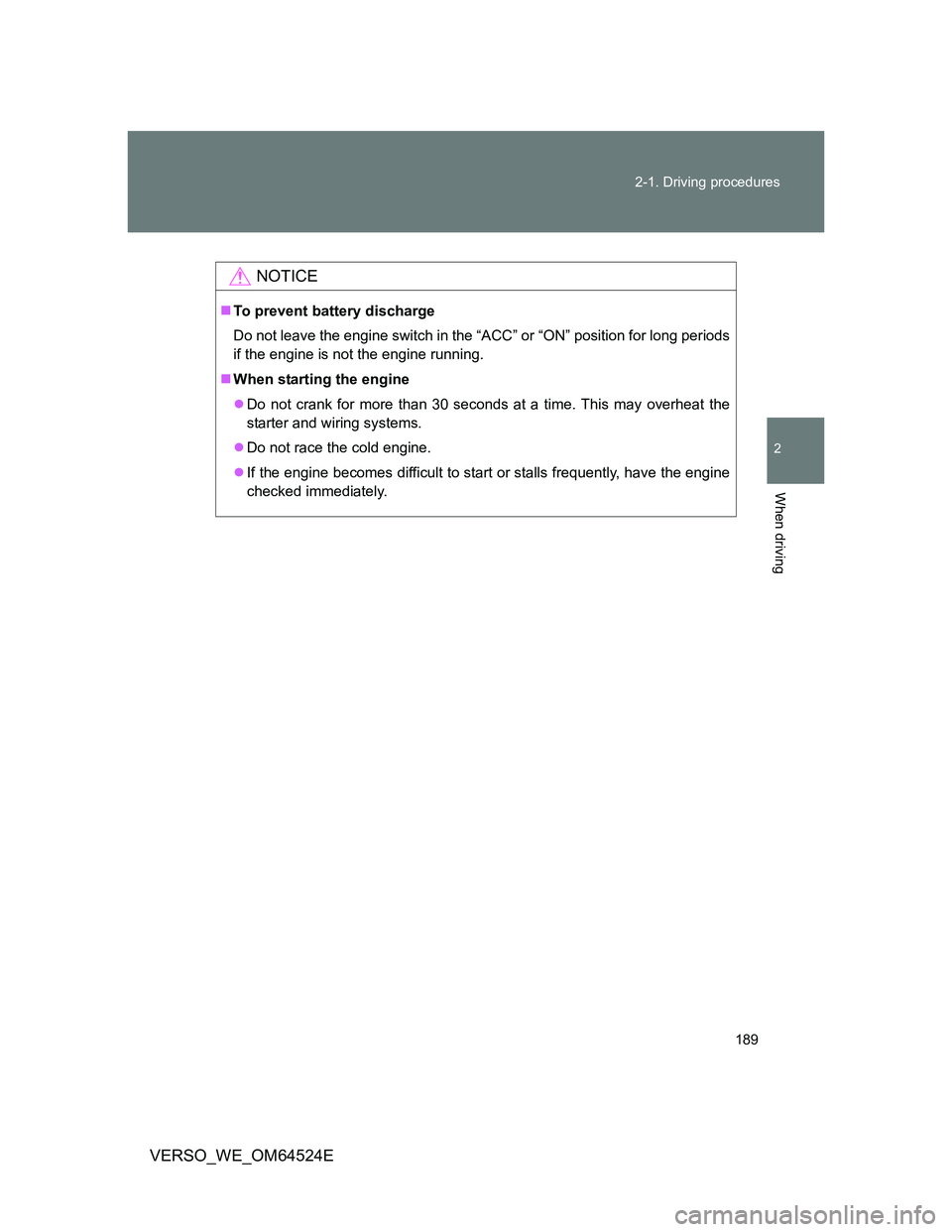
189 2-1. Driving procedures
2
When driving
VERSO_WE_OM64524E
NOTICE
To prevent battery discharge
Do not leave the engine switch in the “ACC” or “ON” position for long periods
if the engine is not the engine running.
When starting the engine
Do not crank for more than 30 seconds at a time. This may overheat the
starter and wiring systems.
Do not race the cold engine.
If the engine becomes difficult to start or stalls frequently, have the engine
checked immediately.
Page 193 of 588

193 2-1. Driving procedures
2
When driving
VERSO_WE_OM64524E
If the engine does not start
The engine immobilizer system may not have been deactivated. (P. 112)
Steering lock
When the “ENGINE START STOP” switch is turned off and then a door is
opened and closed, the steering lock function locks the steering wheel in its
current position. The steering lock is disabled when the “ENGINE START
STOP” switch is operated again.
When the steering lock cannot be released
Steering lock motor overheat prevention
If the engine is started and stopped repeatedly in a short time, operation of
the steering lock motor is restricted to prevent overheating. If this occurs,
wait momentarily without operating the “ENGINE START STOP” switch. The
system will return to its normal condition in approximately 10 seconds.
When the “ENGINE START STOP” switch indicator flashes in amber
The system may be malfunctioning. Have the vehicle inspected by any
authorized Toyota dealer or repairer, or another duly qualified and equipped
professional, immediately.
Auto power off function
Vehicles with a Multidrive or an automatic transmission
If the vehicle is left in the ACCESSORY mode for more than an hour with
the shift lever in “P”, the “ENGINE START STOP” switch will automatically
turn OFF.
Vehicles with a manual transmission
If the vehicle is left in the ACCESSORY mode for more than an hour, the
“ENGINE START STOP” switch will automatically turn OFF.
The green indicator light on the “ENGINE
START STOP” switch will flash and a
message will be shown on the multi-infor-
mation display. To free it, press the
“ENGINE START STOP” switch while
turning the steering wheel slightly in
either direction.
Page 221 of 588
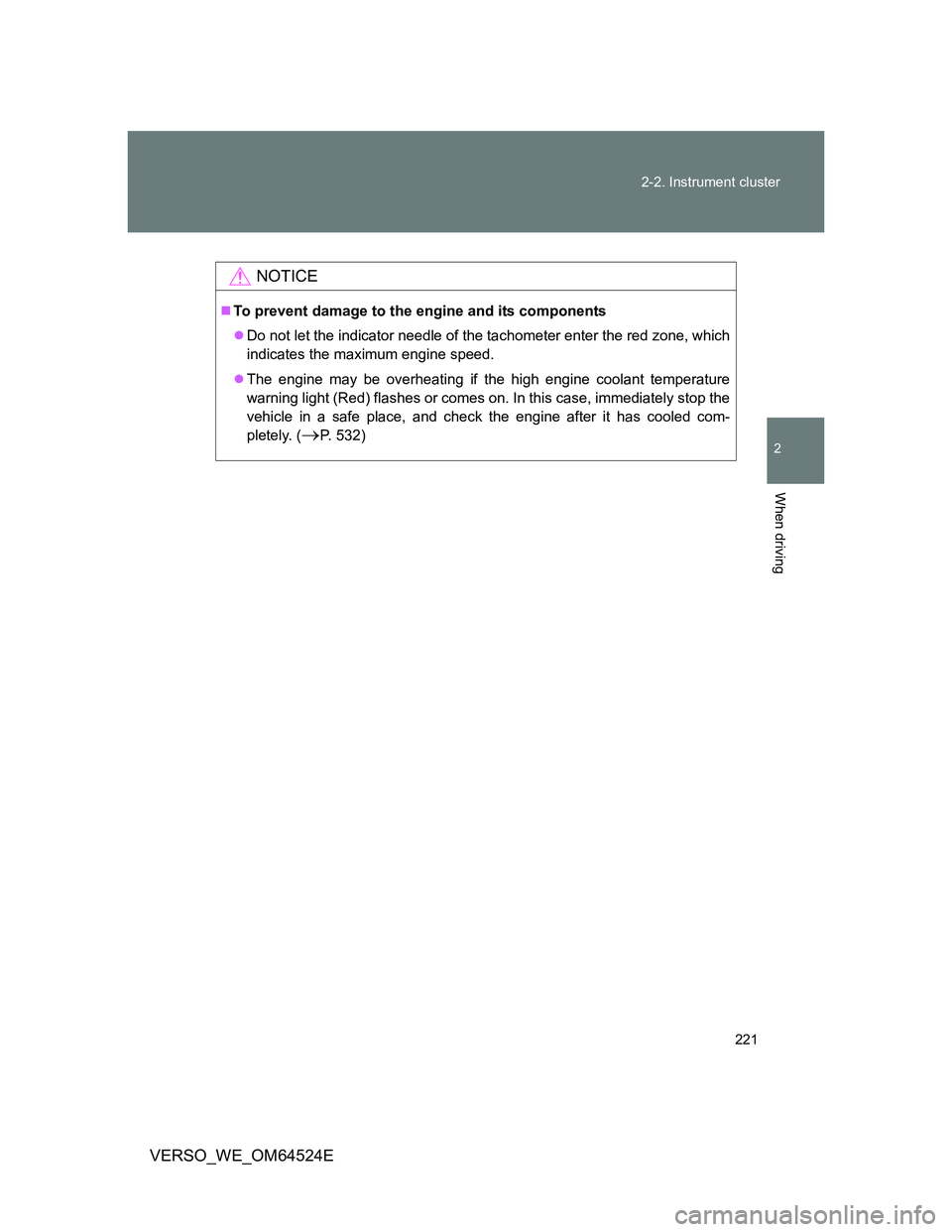
221 2-2. Instrument cluster
2
When driving
VERSO_WE_OM64524E
NOTICE
To prevent damage to the engine and its components
Do not let the indicator needle of the tachometer enter the red zone, which
indicates the maximum engine speed.
The engine may be overheating if the high engine coolant temperature
warning light (Red) flashes or comes on. In this case, immediately stop the
vehicle in a safe place, and check the engine after it has cooled com-
pletely. (
P. 532)
Page 250 of 588

250 2-3. Operating the lights and wipers
VERSO_WE_OM64524E
Vehicles with smart entry & start system:
If the wiper switch is turned to the “AUTO” position while the “ENGINE
START STOP” switch is in the IGNITION ON mode, the wiper will operate
once to show that “AUTO” mode is activated.
If the wiper sensitivity is adjusted to higher, the wiper may operate once to
indicate the change of sensitivity.
If the temperature of the raindrop sensor is 85°C (185°F) or higher, or
-40°C (-40°F) or lower, automatic operation may not occur. In this case,
operate the wipers in any mode other than “AUTO”.
If no windshield washer fluid sprays
Check that the washer nozzles are not blocked and if there is washer fluid in
the windshield washer fluid reservoir.
CAUTION
Caution regarding the use of windshield wipers in “AUTO” mode
The windshield wipers may operate unexpectedly if the sensor is touched or
the windshield is subject to vibration in “AUTO” mode. Take care that your
fingers or anything else do not become caught in the windshield wipers.
NOTICE
When the windshield is dry
Do not use the wipers, as they may damage the windshield.
When the washer fluid tank is empty
Do not use the washer when the washer fluid tank is empty. This may cause
the washer fluid pump to overheat.
When there is no windshield washer fluid spray from the nozzle
Damage to the washer fluid pump may be caused if the lever is pulled
toward you and held continually.